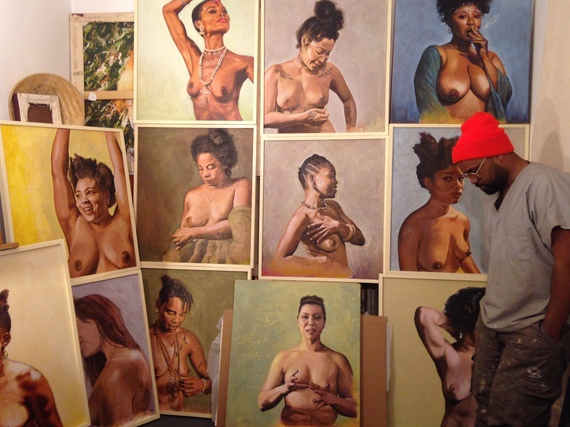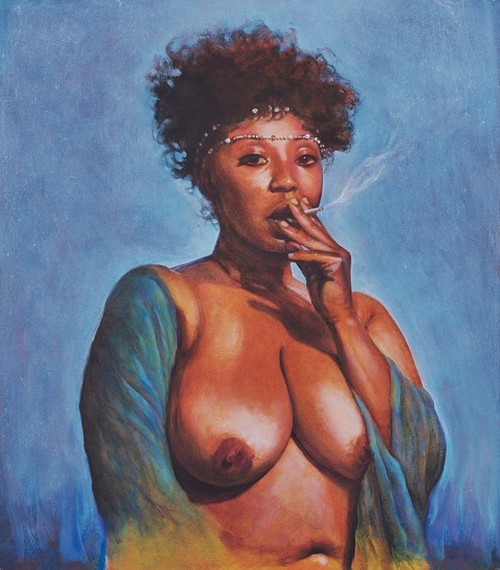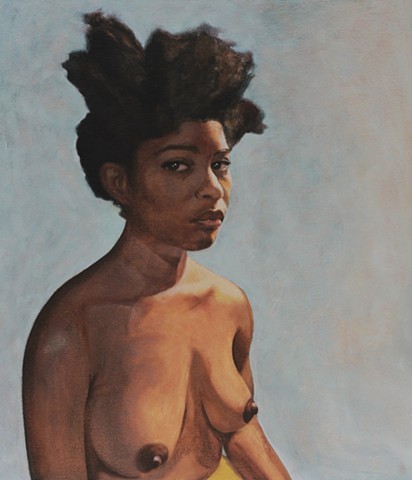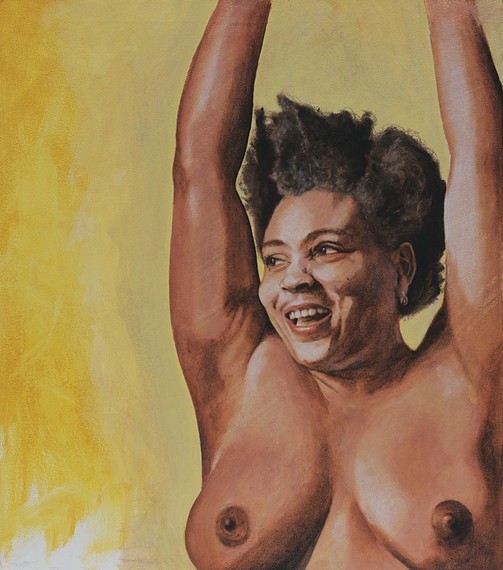My friend painter Ajamu Kojo has been producing beautiful portraits of women for years. I recently got an opportunity to have a long discussion with him in his studio about, painting, women, race, music, barbershops, the human condition and more painting. Here is an abridged version exclusively for readers of the Huffington Post.
____________
MN: I think all these paintings have a high amount of intimacy. The intimacy I'm sensing maybe because you trying to catch that honest moment. Perhaps a certain kind of honesty- if I'm reading it correctly, this intimacy comes out of this honest moment where you capture something real and you create an intimacy with the viewer. So the viewer feels perhaps that they are stepping into something light. They don't seem like they are people's private moments. Everyone seems very carefree. Maybe its because they are your friends and they trust you. They know you are going to make a really great picture.
AK: Yeah, also I think the intimacy comes from a certain level of respect. All these paintings are based on my own photographs. In the same way we are having a conversation now, is the same way I have conversations with these women and I'm hoping to get something natural.
MN: And you do at some point. You take enough shots, it happens.
AK: This is one of the first ones, turned into a personal favorite and she's a spectacular writer.
____________
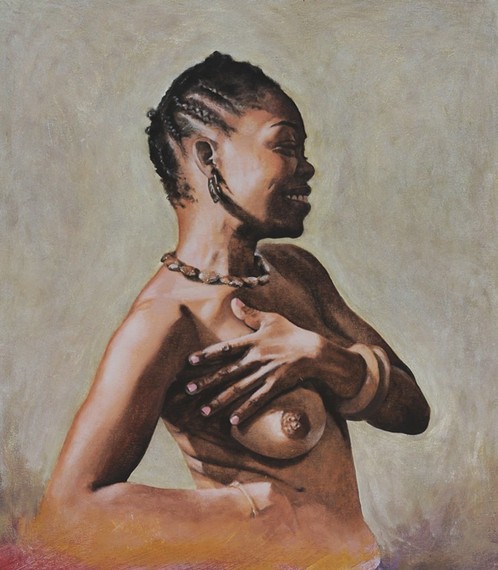
MN: Let me ask you has your work always been figurative or is this a narrowing down process where you figured out the thing you wanted to do?
AK: I think this is a narrowing down process of me honing in on the technical aspect of my approach. My work started off as more political one-sheet posters, graphic, a little bit more illustrative. Ok then let me try my hand at academic figurative study. I love looking at people. I love looking at the way people move, and how they act and respond. Let me focus on people. And I'm somewhat of a perfectionist so I wanted to get that down and then who knows where this is going to carry me, but right now this is the focus. I am working on some abstract paintings right now. Trying my hand at that. (Doing that) Simultaneously while I'm working on figurative work.
MN: In the background here (pointing to portraits peaking out behind paintings) there seems to be a few men. Now I'm surrounded in a room full of portraits of beautiful women. By the way I don't know if all your friends are beautiful like this, but we should hang out more.
AK: (laughing) Amen brother, because a lot of these women are single and I'm just saying. They are always asking, "Ajamu-don't you know any single guys? Any available men?"
MN: (laughing) So anyway there's a couple of men tucked in here. In fact they are very tucked away.
AK: They are.
MN: Who are the men and why not as many men?
AK: You know what? Actually it may surprise you; in fact it's already in the pipeline where men are the focal point. You know, like I said, I'm already working on some abstract paintings. That's also in the room. So you got a little bit of everything here. That's probably not the answer you were looking for.
____________
MN: I don't know Barkley Hendricks
AK: Oh man, you gotta get on him. He's awesome. Barkley Hendricks is definitely an influence in my work.
MN: I see a little bit of Philip Pearlstein.
AK: I've been given that complement
MN: I love Pearlstein. He's a wonderful painter. Who else do you think about?
AK: I think about Mati Klarwein. He's the most famous artist you never knew. Did a lot of album cover art. He does a lot of fantastical art. (Picks up book)
MN: I know who this guy- Santana, Bitches Brew.
AK: Which is why I decided to go to Austria to learn the technique I employ in my work.
MN: We talk about music a lot.
AK: This was the album cover that got me into him. Miles Davis's Bitches Brew, I was like who the fuck painted that shit?!?
MN: He clearly did a lot of acid.
AK: Once I figured out who he was, I started figuring out who he was and started buying buys books on him. Trying to find out who it was. I finally found someone who taught the technique he used out in Austria. So off to Austria I was.
MN: What is Mischtechnik?
AK: It's called the Mischtichnik. Which is basically the mix technique that is egg tempera and oil glazes.
MN: The egg acts as a binder. It allows the oiled based painting to interact with the tempera base. Why Mischtechnik. It seems like a serious commitment to go to Austria to learn something very specific.
AK: I was like, I gotta do that. Get my passport and travel outside of the United States.
AK: Whom did you admire when you started to gain an insight into the craft you were honing? So when I learned about Mati, he uses this technique. I wanted to paint like him. Then you find your own way.
MN: When I used to paint as a teenager I wanted to be Salvador Dali. I would drop acid and trip out on Dali. I think he's a good first painter for young people.
(Klarwein) went to Dali to show him his paintings. He wanted to get put on.
MN: That makes sense.
AK: Dali's response was, "You're too religious." (laughs) So yeah-I wanted to paint like him. Then you realize years down the road that I don't want to paint like him, but I want to embody that spirit.
____________
MN: Listening to Sun Ra is a little different than listening to other jazz. Don't you think? I like the spacey stuff.
AK:I don't remember how I got turned on to Sun Ra's music which by the way is going to be a series I'm going to do.
MN: We were talking about influences before. Let's talk about these three painters. We spoke about Mati Klarwein..
AK: Pietro Anigonni, and Barkley Hendricks.
MN: So, are those like your top 3? Or three to matter to you in this time?
AK: For now. These are the three that permeate.
MN: Right now. All figurative guys.
AK: Gerhard Richter is influencing my move into abstract painting.
MN: He was a huge influence on me.
AK: Simultaneously with figurative. I am into Gerhard Richter right now.
MN: Yeah and you want to bring a certain surface quality to it too. Your paintings are painted in a rigid academic style. I think your recent experiments with abstract painting; do you see that as a way to free yourself up?
AK: I need a foundation at least, and then maybe once I become a little more comfortable I will be a little more spontaneous. It's nice to have that little safety net. It's a growing process.
MN: There's a great quote in the documentary about the punk band The Minutemen and Mike Watt is like, "We didn't even know you had to tune your guitars." We didn't know that was a thing. I'm paraphrasing. He's like, "Some guys like their strings loose and other guys like their strings tight."
AK: (laughs)
MN: So I look at these paintings and I think, this guy likes his strings tight.
AK: You know what it is with me and it's always been this way with me since I was a child is finding a balance. Maybe the abstract is the loose and this is the tighter.
MN: the grounds on these are loose. There's a real brushy element in the backgrounds so they are not flat. They photograph with a little depth but you see it more so in person. The photographs flatten your backgrounds more.
AK: It's difficult to get all that texture in there.
____________
AK: It's returning.
MN: Do you think painting black women is a political statement onto itself? There are other kinds of women here, but it's mostly black women. Maybe because that's mostly who you hang out with?
AK: mm-hmm
MN: so it is a political act?
AK: I don't think black people are represented as often as they need to be. This is just my personal opinion. In paintings specifically and then to have black women, who in western society as Zora Neale Hurston would say are the "Mule of the earth". Whom we are all begat from until proven otherwise. It's such a contradiction, it's who we come from and women from color are treated as... at least in the United States.
MN: In a country dominated by white males, it's threatingly opposite to the white male.
AK: Not only that...
MN: these paintings are about empowerment.
AK: Yes, men and not only white men, I guess I could say white men, but men are so insecure that they structure a society that oppresses women. So I'm taking a woman who comes from a society; a matrilineal society where the king's son can't be king but the king's sister's son can be king and is passed down as the one. Dude, I got a Jewish woman on canvas, I got a Latina woman on canvas, but black women are the women I come from.
MN: I see it both ways. It's about empowerment. It's about empowering the black woman whom is often mistreated in patriarchical society. It's also an act of convenience because these are the people in your life. So there is the journalistic aspect concerning people who you know in your world, yet who happen to be women you want to empower because they are representative to something larger in society.
AK: Yes, we want to see human beings excel and evolve, but who doesn't want to see their family. If we are going to split hairs and say these people we are calling white and these people we are calling black. You want your people to feel good. Especially if they have been oppressed as long as they have been oppressed.
MN: Sitting in a room full of oil paintings of mostly black women and we talk about race, right? If we were sitting in a room is a room of (paintings) white women, would we be talking about race right away?
AK: If we were both black, we probably would be. If we were both white, probably not.
MN: since I'm the weird mix I am, whatever I could be identified with, and you are black we ended up at that place or because if we were both white guys, would it be the same conversation.
AK: I don't know, but I know as a black man race related issues are on my mind everyday. So maybe I steered that a little bit? (laughs)
MN: It's interesting; I don't feel one way or the other about it.
AK: I like talking about race, especially with someone who is not black.
MN: Me too.
AK: You like to push the envelope. (laughs)
MN: (laughs) you bet I do and why not?
AK: It's boring otherwise. You know what it is!
MN: (interrupts) It's all done with love. That's the difference,
AK: Here's the thing. We were having a conversation on Girls (TV show we work on sometimes) and you checked in and were like showing mad respect, You wanted to make sure that didn't get to (uncomfortable).
MN: It did get far out. We were joking about Hitler in black face which I still find funny.
AK: Most people don't even check in. sometimes it's because they are assholes, or sometimes they are just ignorant and don't know any better. You got to educate people on etiquette. C'mon, you gonna say some wild shit like that in 2015?
MN: The thing with me is that, all the humor is done with love and respect. It's just how I feel.
AK: You're educated. Some people are not.
MN: In your personal life, how politically active are you? Do you feel like the work is the protest? Or are the acts in your personal life politicized as well? Where does it start? Where does it end?
AK: I don't think it ends. Ever. It may be more apparent in my work because it's cathartic to me. Every day you wake up and walk out the door you will deal with some sort of political bullshit. Or feel as though you have to. Even in the work force, you have to play chess.
MN: Especially in the work force. More so than anywhere else.
AK: That's where we spend a good deal of our time.
MN: And a lot of jokes wasted.... Here's one: The art world. How involved are you?
AK: I'm a baby, man, it was a little discouraging at first. OK, I'm just not figuring it out. We've spoken about this before. I wanted to be a filmmaker and you wanted to be a painter and here doing the opposite things. Which makes perfect sense. So (the art world) is sorta new for me. I knew that it's always been there.
MN: As far as your level of engagement?
AK: I'm looking at it like, fuck-I've waited this long. I saw an interview with Toni Morrison and I don't know the full story, but the abridged version is she didn't start writing until she was 40. She's a Nobel Prize winner.
MN: Yeah man, like deKooning didn't sell a painting until he was 47. I know you got one up on him. I feel the same about my own work; a lot of it is a social business.
AK: It's also about when you mature into a certain level of command over your craft, or knowledge, or confidence. It's like what the fuck am I fucking around for? I know I'm a badass at this shit. So you start projecting it and people start noticing it. So that's happening and it happens when it's supposed to happen or whatever the fuck that means.
____________
AK: I don't know what else to do though. There's the long-standing tradition in my family of barbers. I've always fancied the idea of having a barbershop that's like painting and drawing.
MN: There is something that always interested me about you, that you are a barber. You must be a good one. You've done it forever. Isn't everyone in your family a barber?
AK: All my uncles are barbers. It was part of my life. I never went to a barbershop. If I needed a haircut my pop was cutting my hair. Since I already had that interest in art, draftsmanship, the language translated. So then I started thinking about designs. I would sketch it out on a crudely shaped head. I was like wow- you can draw pictures in this textured hair. (laughs) Hell, it's on now. My little brother was into Teenage Ninja Turtles and he asked me to cut one of them motherfuckers into the back of his head. So he was going to school with the flyest haircuts in Little Rock Arkansas. (laughs)
MN: (Laughs) I love this story. I remember this (cultural) moment too. You got a couple of years on me but it was this great moment in black culture where people were shaving stuff into the sides of their head more. People have done it since.
AK: we're both hip-hop aficionados. In addition to dance, I'm looking at Big Daddy Kane's video and thinking, "who the fuck cut his hair like that?"
MN: Did he have a Gumby?
AK: He had a flat top with the part from one side of his head with the other parts intersecting. One long part cut into the high top fade, with that shit. It was fucking awesome.
MN: (laughs) I digress, tell me about barbershop culture. I know it's a thing.
AK: It's a total thing bro. It's the waterhole where men get to go and bitch.
MN: Do women ever go to the barbershop?
AK: They do so now more so then when I was coming up. I came up during Tribe (Called Quest).
MN: There were great haircuts then.
AK: It was the tail end of gangsta rap.
MN: There are actually great haircuts in all these paintings. The hair is well painted. Especially hers. The subtlety.
AK: Thank you.
MN: In some you are not doing much.
AK: Like (John Singer) Sergeant a little dab there.
MN: Actually, I see the barber in these. I never put it together until now, but I've known this(about you) for a very long time.
AK: This is one of the first ones, turned into a personal favorite and she's a spectacular writer.
MN: The light is so right, the blue in the back is complimentary to the skin tone. There are a lot of yellows and oranges inside the brown. And the blue shade.
You do a lot of dry brushing to bring out highlights. You don't see that in the photos. They look smoother.
AK: I like the texture of the canvas, but I like the sturdiness of the board. I tend to do canvas glued to board. Lately its linen canvas with the abstracts, which is a pleasure.
MN: This one of your wife Nucomme is special. I don't know if it's emanating the quality of the relationship. But there is something about the way you cut in the yellow. It's satisfying to the eye. These clean forms where you cut in the background have luminosity.
AK: You know what I'm thinking about right now?
MN: What's that?
AK: That motherfucking soup my wife made.
MN: OK, we're done.

